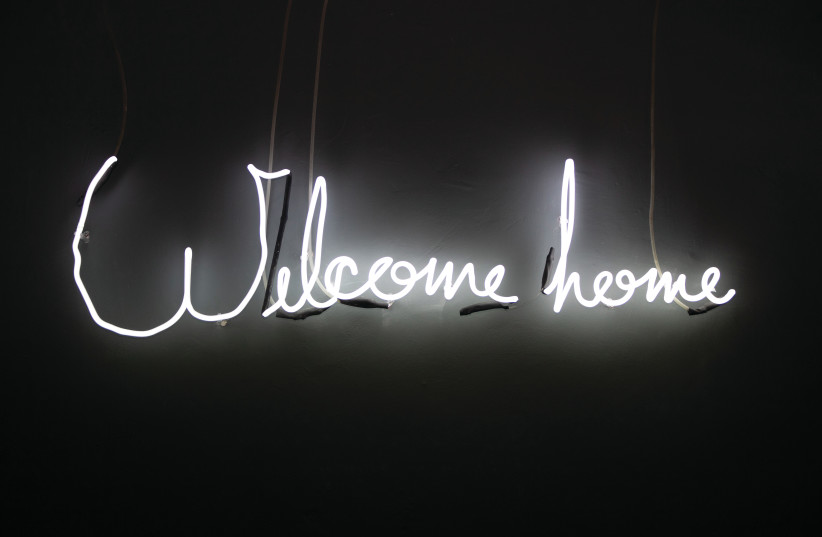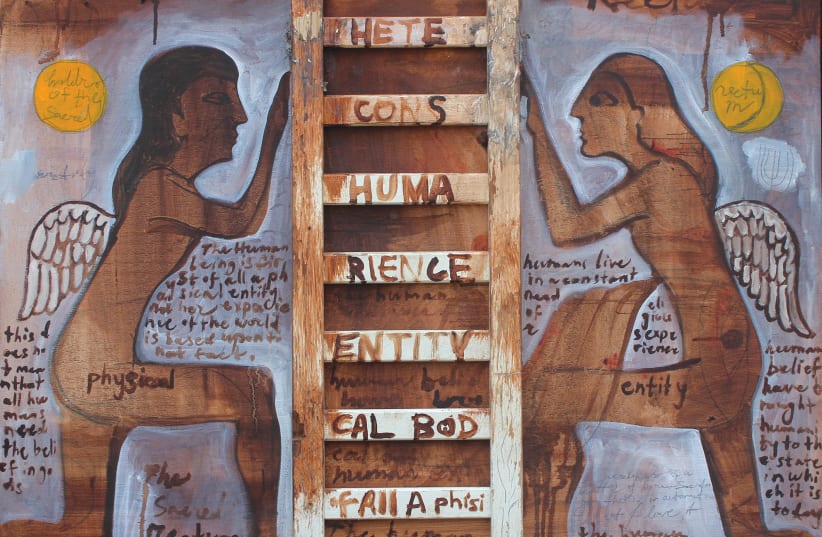

Art has many roles to play in our lives. Offering aesthetically alluring and, hopefully, emotionally and cerebrally compelling creations is certainly one of them. The items currently hanging on the walls at the Museum on the Seam answer to all the above descriptions.
All told, there are five exhibitions running at the non-mainstream repository of art over at the interface – as its name suggests – of several of the capital’s ethnically, religiously, and culturally diverse, if not disparate, sectors. All opened on March 13, with three featuring in the latest incarnation of the Jerusalem Biennale.
Four are due to close at the end of May, with the most compact of the fivesome, “Welcome Home – Come Home,” to remain in place until all the hostages in Gaza are released. Let’s hope the closing date for that comes sooner rather than later.
What's on display?
The eagle-eyed will have noted the similarity between the braces of words on either side of the dash in the title of Nelly Agassi’s offering. Should, somehow, that not immediately catch the eye, you can’t avoid the only slightly subliminal message in situ, as the first three letters of the first word blink on and off. In fact, the neon work is the result of a collaboration between Agassi and her son, Emmanuel Evron-Agassi.
“Nelly took the lettering for this from her son’s handwriting, when he was just learning to read and write,” explains museum deputy director Shahar Shalev. “There is something innocent about the way it looks.” That, indeed, befits a scribe of such tender years, but the source of the lettering stands in stark contrast to the plaintive gist of the fluctuating textual content.


THE MINIMALIST sign is, in fact, a scaled down version of the original work which was created for O’Hare International Airport in Chicago. Agassi and her family relocated to the Windy City 13 years ago, and the beacon, as the museum notes: “illuminates personal and collective experiences of distance, longing, and the ambivalence of being neither here nor there, while succinctly expressing the expectation and relief of coming home.”
While the expectation – or more likely the hope – that all our hostages will eventually come back to their loved ones, in a reasonable physical and emotional state, has been omnipresent in our lives for the past half a year, the notion of relief still seems some way off.
The principal thrust of the museum spread references texts of a religious traditional ilk, looked at from way out in left field. That appears under the “Orayta: From Content to Form” umbrella with works by artists who fed off sacred texts as a pliable, user-friendly base material for their flights of fancy.
As the moniker infers, the exhibitors trained their thoughts and innovative skills on the shapes of the textual formats rather than their literary, thematic, or intellectual import. One striking example of deliberately turning a blind eye to the meaning of the words on the page is the quirkily and lengthily titled An Introduction to the Principle of Relative Expression by Joseph Sassoon Semah.
Semah – who was born in Baghdad in 1948, made aliyah with his family at the age of two, and subsequently immigrated to Amsterdam – completely obliterated the text from the Babylonian Talmudic tractate of Pesachim – currently a timely seasonal festive choice – so that all we see is mostly irregular black shapes divided by white demarcation lines where the individual blocks of text end.
Semah’s contribution comprises one of a quartet in the opening exhibition space, which also includes a laser-cut metal assemblage called Fragile by Arik Weiss. There is also a seeming reprise to the Semah work by Netanel Bollag, a secular Jew with haredi roots. The Untitled picture is even more obscure than Semah’s, for which Bollag used sand-colored oil paint daubed over a page of the Talmud affixed to canvas.
INTRIGUINGLY, BOLLAG complements the painted component, which echoes Semah’s blacked-out effort with lighter delineation intervals leaving a skeletal effect, with a few lines from printed religious promotional material designed to draw the attention of haredim, Talmudic scholars, and disciples, as well as the general public, to the fact that there are “more than one hundred new and worthy additions.” You can’t miss the artist’s oxymoronic, possibly tongue-in-cheek, avenue of thought in not allowing us to read those “additions.”
Shalev says that is very much in keeping with the current trend in Jewish artistic circles. “The reasoning behind the exhibition, as you can see in the name, is to highlight a pattern in contemporary Jewish art whereby there is movement away from using the content of sacred texts towards making use of the substance of the sacred text as raw material for the work itself.”
That, she explains, can ebb and flow across variegated creative tracts. “There are, for example, artists who mark the sacred text, delete it, or even tear it or blur it.”
That sounds a mite sacrilegious. “Yes, some people say that straight off,” Shalev concurs. “But if you delve a little more deeply into the subject, you might discover there is even a dimension of sanctity or exaltedness.”
Shalev argues there are even legitimate grounds, from within the fold, for a tangible take on textual matter. “In Jewish tradition, there is actually consideration given to the material property of the sacred text to no less a degree than to the content of the text.” She proffers collateral for the claim. “There is, for example, Chazal [sages of the Mishna and Talmud] and, later, the Kabbalists and all sorts of similar Jewish traditions that even call on us to focus on the vacant places, the spaces between the letters, or even to read a sacred text without trying to understand it.”
That suggests a highly sensorial experiential approach that also leans toward the visual aesthetics, coupled with assiduousness. One only has to think of Torah scroll lettering and the scrupulous attention the scribes must pay to their work. If even one of the over 300,000 letters is in any way imperfect, the whole scroll is disqualified from use in synagogue services.
THE DISPLAYS also feature video works and all manner of sculpted figures.
The former includes a video-animation work by Raya Bruckenthal called A-Goldnae Gan Eden (Golden Paradise). Interestingly, she turns the abstraction process on its head and converts images into text. She opens with a segment of a page from the book Tzena U’Rena (“Go Forth and See,” conjugated to particularly address women) which was written in Yiddish in the late 16th century. The segment shows an illustration of Adam and Eve naked in the Garden of Eden.
Bruckenthal took the image and ran with it to produce a large pixelated 3D reproduction. The video shows shapes morphing into letters, and vice versa, in a mesmerizing visual continuum that pits shape against writing, and the corporeal against the stylized font.
One work that manages to convey a sense of heightened emotion, despite comprising text alone – albeit in a singularly aesthetic form – is Fingerprint of Horror by Adi Drimer. It is one of the few exhibits that directly reference the horrific events of Oct. 7.
Drimer comes from that neck of the woods, Kibbutz Re’im, and followed the tragic developments as they evolved, from her safe room, via the kibbutz WhatsApp group. She was eventually evacuated to Eilat, along with the other surviving members of the kibbutz. She created Fingerprint of Horror during an art therapy session given to the kibbutzniks in the hotel in which they were billeted. The work incorporates all the WhatsApp exchanges during the Hamas attack, which Drimer faithfully and tastefully reproduced in an elongated spiral shape.
“The exhibition, in general, relates to the secularization of sacred texts. Adi Drimer’s creation reverses that process perfectly: She sanctifies a secular text,” Shalev notes.
FEMINISM ALSO has a significant place in the museum offerings, chiefly by courtesy of a series of works by Dutch artist Marcelle Hanselaar. The 79-year-old London-based painter and printmaker references a slew of biblical stories that feature women in major roles. Hanselaar pulls no punches as she portrays women as powerful, uncompromising, tender, driven, loving, willful, and even vengeful.
Her slot at the museum is called Rebel Women from the Apocrypha. It feeds off the Judeo-Christian biblical tradition, although does not relate to the main characters via a religious prism. The Knowing, Sisera’s Mother etching and aquatint work portrays the killing of Canaanite military commander Sisera by his hostess Yael. Hanselaar pulls strongly on the heartstrings by including Sisera’s mother waiting anxiously for her son’s return. There is also a fierce and sexually charged encounter between Adam and Eve in the series.
The basement level of the museum is also well worth a visit. Assi Meshullam is similarly hard-hitting with his Tophet layout. “Tophet” translates as something along the lines of “horror, inferno, terrible pain, or disaster,” and there is a suitably feral element to the collection. Meshullam features the polytheist worship of the Moloch deity at Gehenna in the outskirts of Jerusalem.
Ancient Egyptian iconography also makes an appearance but with Meshullam’s singular take, which has largely unintelligible text and truncated shapes and lettering that leaves the viewer with food for thought. ■
For more information: www.mots.org.il/












